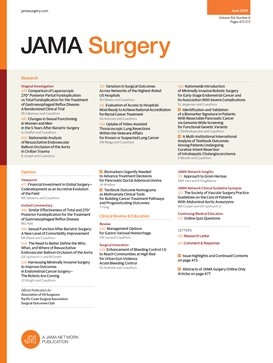非β-内酰胺类抗生素使用,β-内酰胺类过敏和手术部位感染。
IF 14.9
1区 医学
Q1 SURGERY
引用次数: 0
摘要
重要意义手术部位感染(ssi)造成重大的健康和经济负担。β-内酰胺类是大多数外科手术中推荐的预防性抗生素;然而,非β-内酰胺类抗生素与SSI发生率的关系存在争议。目的评估不同外科专科报告的β-内酰胺过敏状态、β-内酰胺类抗生素和ssi之间的关系。设计、环境和参与者:这是一项前瞻性记录数据库的回顾性队列研究。这是一个第四卫生中心。该研究包括在2021年1月至2024年2月期间接受手术的患者。暴露研究暴露包括抗生素选择和报告的β-内酰胺过敏,协变量包括人口统计学、合并症和手术细节。主要结果和测量主要研究结果为30- 90天SSI发生率。结果本研究纳入10个专科49 279例手术,共41 100例患者(平均[SD]年龄61.0[15.9]岁;范围13-103岁;21 237例男性[51.7%])。使用非β-内酰胺类抗生素的手术组SSI发生率高于使用β-内酰胺类抗生素的手术组(2.2% vs 1.3%;风险比[RR], 1.69; 95% CI, 1.28-2.01; P < .001)。报告β-内酰胺过敏患者的手术SSI发生率较高(1.8% vs 1.3%; RR, 1.38; 95% CI, 1.15-1.64; P = 0.003)。这些关联在逻辑回归中也存在。然而,在控制协变量和β-内酰胺过敏的情况下,非β-内酰胺类抗生素的使用仍然与较高的SSI发生率显著相关(优势比[OR], 1.33; 95% CI, 1.00-1.74; P =。04),而β-内酰胺过敏与SSI发生率之间的关联变得不显著(OR, 1.21; 95% CI, 0.97-1.49; P = 0.09)。在亚专科分析中,只有骨科手术保留了非β-内酰胺使用与SSI增加之间的显著关联(OR, 3.01; 95% CI, 1.41-6.01; P = 0.003)。结论和相关性本队列研究发现,β-内酰胺预防与非β-内酰胺药物的SSI发生率显著降低相关,并且报告的β-内酰胺过敏并不能独立预测感染风险。以过敏为重点的管理指南的实施与非β-内酰胺使用的显著减少有关,强调了精确过敏评估以避免不必要的替代预防的重要性。本文章由计算机程序翻译,如有差异,请以英文原文为准。
Non-β-Lactam Antibiotic Use, β-Lactam Allergy, and Surgical Site Infections.
Importance
Surgical site infections (SSIs) pose significant health and economic burdens. β-lactams are the recommended prophylactic antibiotics for most surgical procedures; however, the association of non-β-lactam antibiotics with SSI incidence is controversial.
Objective
To evaluate the association between reported β-lactam allergy status, β-lactam antibiotics, and SSIs across various surgical specialties.
Design, Setting, and Participants
This was a retrospective cohort study of a prospectively recorded database. The setting was a quaternary health center. Included in the study were patients who underwent surgery from January 2021 to February 2024.
Exposures
Study exposures included antibiotic choice and reported β-lactam allergy, with covariates including demographics, comorbidities, and procedure details.
Main Outcomes and Measures
The primary study outcome was 30- to 90-day SSI incidence.
Results
The study included 49 279 procedures across 10 specialties, with a total of 41 100 patients (mean [SD] age, 61.0 [15.9] years; range, 13-103 years; 21 237 male [51.7%]). Procedures with non-β-lactam antibiotic use had a higher incidence of SSI than procedures with β-lactam antibiotic use (2.2% vs 1.3%; risk ratio [RR], 1.69; 95% CI, 1.28-2.01; P < .001). Procedures in patients with reported β-lactam allergy had a higher incidence of SSI (1.8% vs 1.3%; RR, 1.38; 95% CI, 1.15-1.64; P = .003). These associations were present in logistic regression as well. However, on controlling for covariates and β-lactam allergy, non-β-lactam antibiotic use remained significantly associated with higher SSI incidence (odds ratio [OR], 1.33; 95% CI, 1.00-1.74; P = .04), whereas the association between β-lactam allergy and SSI incidence became nonsignificant (OR, 1.21; 95% CI, 0.97-1.49; P = .09). In subspecialty analysis, only orthopedic surgery retained a significant association between non-β-lactam use and increased SSI (OR, 3.01; 95% CI, 1.41-6.01; P = .003).
Conclusions and Relevance
This cohort study found that β-lactam prophylaxis was associated with significantly lower SSI rates than non-β-lactam agents, and a reported β-lactam allergy did not independently predict infection risk. Implementation of an allergy-focused stewardship guideline was associated with a marked reduction in non-β-lactam use, underscoring the importance of precise allergy assessment to avoid unnecessary alternative prophylaxis.
求助全文
通过发布文献求助,成功后即可免费获取论文全文。
去求助
来源期刊

JAMA surgery
SURGERY-
CiteScore
20.80
自引率
3.60%
发文量
400
期刊介绍:
JAMA Surgery, an international peer-reviewed journal established in 1920, is the official publication of the Association of VA Surgeons, the Pacific Coast Surgical Association, and the Surgical Outcomes Club.It is a proud member of the JAMA Network, a consortium of peer-reviewed general medical and specialty publications.
 求助内容:
求助内容: 应助结果提醒方式:
应助结果提醒方式:


